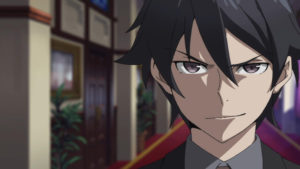In a future where the technology to travel space and inhabit other planets has been developed, humans have expanded their reach beyond Earth and colonized Mars. One of Japan’s new prefectures on the planet, Fourth Tokyo, is home to the elite Kirishina Corporation that specializes in the development of space aeronautics technology. The company also runs the Kirishina Science and Technology Academy High School, where advanced students develop rockets as part of the Advanced Technological Development Department, or “A-TEC”. Their status as a class of entrepreneurs is challenged after the arrival of a new student who, tasked with managing and disbanding the department, enforces budget cuts during a critical stage of the development of the new X-2 rocket engine. In order to save their project and their place in the school, the members of A-TEC embark on a mission to convince those in management that their program yields results, all while grappling with the everyday problems of adolescence.

The premise of Classroom Crisis is interesting enough, reminiscent of many other stories that touch on school programs attempting to fight for their budgetary needs and the needs of their students. What differentiates the show from other stories along the same vein, is the addition of the Kirishina Corporation and the political intrigue surrounding it. However, rather than the school and political elements coming together to form a cohesive and balanced narrative, they remain separate and have very little effect on each other. In fact, aside from the new manager and student of the department, Nagisa Kiryu, none of the other characters seem to involve themselves in the political aspects of the show. This makes for a narrative that can’t seem to choose the genre it wants to be and ends up telling two unremarkable stories that run in parallel without intersecting in any meaningful way.

Despite Classroom Crisis being a story that involves a large cast of characters given the school based environment, the focus never really shifts from a core cast of characters except for some comedic quips delivered by other students. The main cast includes the teacher of the A-TEC program Kaito Sera, an A-TEC engineer and Kaito’s sister Mizuki Sera, and the test pilot for the department, Iris Shirasaki. As far as characters go, they are rather static. They each have their own personality to an extent, Kaito is energetic and a little naive, Mizuki is kind and gutsy, and Iris is quiet and suffers from amnesia, a common ailment plaguing many anime protagonists. Unfortunately I didn’t find these characters particularly engaging and what little interest I did have at the beginning was obliterated during the combo Beach Episode™ and Onsen Episode™. With plenty of lewd and embarrassing shots of the female characters, it was a mess of an episode that proved that character arcs and personality weren’t the most important things to the creators of Classroom Crisis. Aside from that unpleasantness, Nagisa Kiryu is arguably the most interesting character in the show since he has a part in both the political and school aspects of Classroom Crisis, as both a manager sent by the Kirishina Corporation and as a student part of A-TEC. The best character moments are also related to him, including his evolving relationship with Kaito from boss and lackey, to student and teacher, and finally, to equals. His story also involves some surprising and not so surprising twists, and he is also the focus of an unimportant and unproductive love triangle involving Mizuki and Iris. In this context the term ‘unproductive’ means that Mizuki and Iris have a falling-out, which is followed by a non-verbally agreement to finally pursue Nagisa individually as friends, without any resolution to his or their feelings on the matter. They never even meet or talk with each other during the final moments of the last episode, so the love triangle just fizzles out in a macro-sized spark of pointlessness.

Classroom Crisis is occasionally clever, but overall ineffective. There were some good episodes, a particular standout was one involving Kaito approaching the company union to try and save the A-TEC department, but these sorts of average episodes were overshadowed by things like the mess that was the Beach Episode™ and Onsen Episode™ rolled into one, and the pointless love triangle. Classroom Crisis is standard but not in a way that makes it approachable. Rather, it is an average show with a visually polished animation style that is weighed down by a lack of direction despite an interesting premise.
A review copy was provided by Madman Entertainment to the author for the purpose of this review.
© 2015 CC PROJECT





